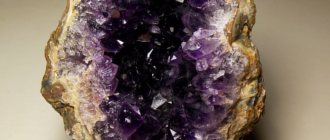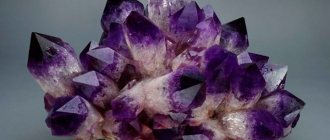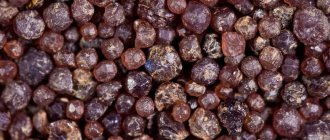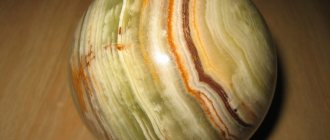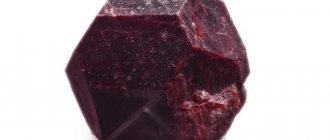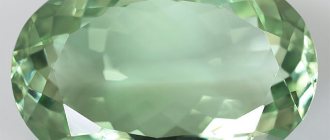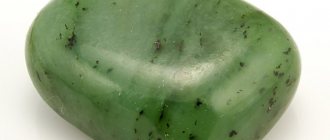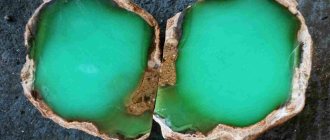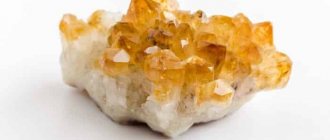History of the name of the fruit
Pomegranate is a wonderful plant. The history of its name is interesting. This plant was known back in the times of the Ancient World. At that time it was believed that the best trees grew in Carthage. The Romans called the fruit malum punicum, which translated means “Punic apple.” The thing is that in the tenth century BC the Phoenicians moved from their native land to Africa, founding new settlements there, including the famous Carthage. And for the Romans, the Phoenicians themselves are Punics, hence the name – Punic apple.
But the pomegranate also had a second name - malum granatum, which means “grainy apple”. It was this that later became very widespread. But the botanical name Punica was given to the plant in 1758 by Carl Linnaeus.
Origin of the stone
The mineral is mined in large quantities on almost all continents. Many countries have deposits of garnets: South Africa, Sri Lanka, USA, India. Our gem is mined in Chukotka, Yakutia, and the Urals.
Appearance and color depend on the area. Specific fractures and chemical composition are determined by the host rock. For example, a dark brown color means that the mineral contains a lot of iron and titanium. Based on physical and chemical characteristics, geologist Sobolev identified 37 representatives of the group.
The chemical composition suggests the mining region. For garnets, examination is rarely carried out, since the stone is usually inexpensive. Only some copies cost more than one thousand dollars.
pomegranate tree
There are different varieties of pomegranates in the world. The plant's homeland is Persia (the territory of modern Iran). Pomegranates grow in the wild and in the Transcaucasus, Central Asia, India, Asia Minor and Afghanistan. In these countries, under favorable conditions, trees can reach five meters in height, but the plant can also be a bush. At the end of the eighteenth century, thanks to the Spanish conquistadors, the crop began to be grown on the American continent.
Pomegranates bloom very profusely from May to August. The plant's large red-orange flowers resemble a bell. They are so beautiful that many people grow the tree just for the sake of flowering. The fruits are spherical in shape and covered with red-brown or yellow-red skin. A pomegranate can weigh up to 600 grams. Inside it there are many seeds surrounded by juicy pulp. It is this that is edible and makes up only 50 percent of the mass of the entire fruit. Each pomegranate contains from 200 to 1400 seeds, located between white partitions. The fruits ripen from September to February in the northern hemisphere, and from March to May in the southern hemisphere. From one tree you can collect up to 60 kilograms of fruit.
The plant itself looks very decorative. In warm climates, ripe fruits crack, hanging directly on the branches. The peel bursts, but the grains are inside and do not crumble. It's just an amazing sight. In temperate climates, the leaves sometimes fall off before the harvest begins. Fruits located on bare branches give the plant an exotic appearance.
General description of pomegranate
Pomegranate is classified as a shrub and tree. The height of plants can reach 2-6 m. The shoots of most varieties are thin, flexible, and colored light brown. The leaves are covered with a waxy coating, oblong in shape, uneven in size (2-8 cm). The leaf blades are attached to the branches using long petioles. The trunk is rough, coarsened, the bark is strewn with small thorns.
Fruit bushes bloom for a long time, starting in May. The flowers are very beautiful, the color is light red with an orange tint. The plant is propagated by cuttings, seeds and layering. Pomegranates are grown not only for food, but also as a decorative element; the photo shows how beautiful the trees look in the garden.
Interesting fact!
Pomegranate, in Eastern countries, is considered a symbol of friendship and fertility. It is used as an element of various rituals on significant family holidays (weddings, christenings, national holidays).
Types of pomegranates
Currently, only two types of culture are known. The common pomegranate grows wild in Asia and southern Europe. The second species grows on the island of Socotra, which is located in the Arabian Sea. Hence its name - Socotran pomegranate. But its taste is significantly lower than that of the common pomegranate, and therefore the plant is not cultivated. In addition, recently a dwarf form of the plant has appeared, which is grown as an ornamental crop on windowsills.
Different varieties of pomegranates, and there are more than 500 of them (cultivated varieties), have different taste qualities, differ in the shape and size of the fruit, the color of the pulp, the color of the juice, the softness or hardness of the seeds. The number of different varieties is increasing thanks to the constant work of breeders, whose main task is to create a plant that will be resistant to all diseases. In Turkmenistan there is the Kara-Kala nature reserve. The largest collection of pomegranates in the world is collected on its territory. There are more than 800 forms, types, and varieties of pomegranate.
Varieties of pomegranate
There are about 500 varieties of guarantor. Breeders are developing new varieties every year. The main emphasis is on breeding a variety that will be resistant to most diseases. Pomegranate is grown in Crimea, Iran and the Mediterranean. In the wild, the fruit grows on the slopes of pine and oak forests.
On a note! In Crimea, there are about 340 species in the botanical garden. These are varieties of both foreign and domestic selection. There are about 800 different forms and species in the reserve of Turkmenistan.
Pomegranate varieties are divided depending on:
- forms;
- type;
- coloring.
The grains also come in different colors and sizes. The main difference is the type of shrub and the region of origin.
Almost all varieties have beautiful double or simple flowers. The bark of the plant is usually brown. The shoots are crooked and quite short. The leaves have an elongated shape. The color is light green. Surface:
- leathery;
- with a little gloss.
The underside of the leaf is matte and has a vein in the middle. The leaves have petioles resembling an ellipse shape. The most common form is:
- lanceolate;
- oblong.
The leaves can reach a length of about 10 cm and a width of 2-3 cm. The plant blooms from May to August.
Pomegranate is divided into 2 main types:
- ordinary;
- Socotran.
Ordinary
The tree grows in the subtropics. It can bear fruit for about 50 years. About 60 kg of harvest is usually harvested from a tree. The height of the bush reaches 6 meters. The branches are quite thin and have thorns. The size of the fruit is similar to an orange. Color varies from yellow to dark red. The growing season reaches 8 months. Fruit ripening occurs on day 150.
Note!
The grains contain citric, malic and oxalic acids, vitamin C and sugar. The peel contains tannins, carbohydrates and steroids.
But there are also side effects. You should not eat pomegranate if you have the following diseases:
- Gastrointestinal tract;
- ulcers;
- erosions.
Persons with allergic reactions should consume the fruit taking precautions. The flower has a funnel shape and a large number of stamens. The flowers are painted in various shades. Pomegranate fruits have thick skin and are shaped like a ball. The weight of one fruit reaches 600-800 grams. Inside the fruit is divided by partitions in which the grains are located. Grains contain seeds. Their color varies from white to dark ruby.
The taste is sweet and sour, the flesh is fleshy and juicy. One fruit can contain up to 1000 seeds. The tree grows in Turkmenistan, Tajikistan and the Caucasus.
Soqotran
It grows mainly on the island of Socotra. Rarely found in the wild. The tree is evergreen. The height reaches 4 meters. The leaves have an oblong shape. The inflorescences are colored pink. The fruits contain a small amount of sugar. Likes to grow on sandy soils. It can grow 300 meters above sea level. Not subject to cultivation.
Depending on the variety, the fruits can be distinguished by their appearance. The peel is:
- scarlet;
- burgundy;
- yellow;
- orange.
The pulp can be white, pink, or crimson. Varieties of this species have a sweeter taste. The taste characteristics of pomegranate are affected by the presence of sucrose and various acids. All varieties of pomegranate can be divided into:
- sweet (sugar content about 18%);
- sweet and sour (sugar content about 10%);
- sour (sugar content no more than 8%).
The taste qualities are most often influenced by the area of growth, climate, and stages of fruit ripeness. Pomegranate requires sufficient heat and light to grow.
On a note!
The most optimal growing area is considered to be the area near the Talysh Mountains.
Main features of sweet fruits:
- the presence of a dark burgundy color in the peel;
- no damage to the skin;
- sufficient fetal weight (at least 150 g);
- woodiness of the stalk;
- no unpleasant odor.
The sweetest varieties:
- Dholka grows in India. The grains are predominantly dark in color.
- Ahmar, grows in Iran, pinkish-red grains
- Nar-shirin, grows in Iran, the grains can be light or crimson in color.
Yellow pomegranates have a sweet taste and virtually no acidity. The grains are colored light pink. When purchasing a yellow pomegranate, you need to make sure that the peel is intact. It should not have dents or damage.
Varieties of pomegranates
We have already mentioned that there are many varieties of pomegranates. All of them are grown for specific purposes. Some are for fresh consumption, others are for processing and juice production. One type of pomegranate makes an excellent and healthy drink, rich in vitamins and microelements. There are also varieties grown for technical processing. In our article we want to present the best varieties of pomegranates and their characteristics. The species grown can be roughly divided into the following groups to show only a small part of the varieties available:
- Sweet Iranian varieties - Sharoli, Halva, Aswad, Akhmar.
- Very sweet Indian - Dholka.
- Sweet and sour varieties - Ulfa, Kyzym, Kok, Wellis.
- Sweet - Lodzhuar, Kadan, Vedana, Nar Shirin.
- American seedless variety (soft seeds) - Wonderful.
- Israeli varieties - Ras el Bahl, Malissi, Red Loufani, Mangulati.
- Indian - Alandi, Bedana.
- Crimean and Transcaucasian varieties that ripen in October are Veles, Kaim nar, Krmyzy kabukh, Shah-par, Bala-mursal, Galyusha pink, Galyusha red.
- Sweet and sour Central Asian varieties - Kzyl-anar, Achik-Dona, Kazake-anar.
- Tart sour variety – Achikanor.
- Early sweet varieties ripening in September - Ulfi, Lodzhuar, Ak-Dona.
- Japanese dwarf variety bred for growing in pots (has numerous small fruits) - Punica granatum var.
- Decorative varieties - Multiplex, Variegata, Chico.
Pomegranate
Product Description
Pomegranate is a fruit the size of an apple or orange, covered with a thick dark red crust. Inside the fruit there are many grains with juicy bright burgundy pulp and a small seed inside.
Pomegranate the Mediterranean and the Middle East. Pomegranate trees bear fruit for many years and live up to about 100 years.
Pomegranate is a complete vitamin and mineral complex . Pomegranate juice contains amino acids that are found only in meat and are essential for the human body (so if you are a vegetarian and eat exclusively plant and dairy foods, then pomegranate should always be on your table). It also contains 4 main vitamins: C, P, B6 and B12: vitamin C strengthens the immune system, P - blood vessels, B6 - the nervous system, and vitamin B12 improves blood formation. In addition, pomegranates are simply ideal for fasting days, since 100 g of pulp contains 62-79 kcal, and 100 ml of pomegranate juice contains 42-65 kcal. Pomegranates are also rich in minerals such as iodine, potassium, calcium, iron, and silicon.
This miracle fruit has a disinfectant effect due to the tannins it contains. Most of these substances are not in the pulp, but in the bark: it can be used for infectious diseases as a herbal antiseptic. Pomegranate juice improves appetite and normalizes the functioning of the gastrointestinal tract. A decoction of its peel will even help get rid of intestinal dysbiosis.
Regular consumption of pomegranates is believed to reduce the risk of breast cancer in women. It is also very useful for various heart diseases. Fresh fruits are effective for coughs, colds and malaria; they are prescribed as a general tonic for exhaustion, anemia and atherosclerosis. In addition, pomegranate has a positive effect on vision: the anthocyanins it contains promote the synthesis of the light-sensitive pigment rhodopsin, which significantly improves the eyes' adaptation to darkness.
Types and varieties
Pomegranate varieties differ in fruit size, grain hardness/softness, degree of sweetness and ripening time. Here are just a few of them.
Dogwood anor is an early ripening variety and can usually be harvested in early October. These pomegranates are grown in Uzbekistan. The fruits are round-flat in shape, come in both small and large sizes, the skin is thin, the grains are medium-sized, dark red in color.
Ak Dona , also known as Tyuyatish (that is, camel tooth) - the variety was bred in Central Asia. The fruits are round-flat in shape, the peel is light with a pleasant raspberry tint, the grains are large, elongated, pink in color, the calyx has a cone-shaped shape with curved edges.
Achik-anor is a sweet and sour variety of pomegranate, its fruits are round in shape, slightly narrowed at the base, the peel is thick, green-carmine in color, the calyx teeth are straight, the grains are large and have a pronounced dark cherry color.
Gyuleysha ( Gyulosha ) pink and red are the best pomegranate varieties growing in Azerbaijan. The fruits of the first representative have a rounded-elongated shape, a thin creamy-pink skin, a cylindrical neck with a narrow cup, medium-sized grains of a dark cherry color. In the second, the fruits reach large sizes, the skin is carmine-red in color with stripes at the base of the fruit, the neck is high and of medium thickness, the edges of the cup are curved or curved, the grains are large and dark cherry in color. Both varieties have a pronounced sweet and sour taste.
Ak Dona Krymskaya is a pomegranate variety with large rounded fruits, has a thin creamy skin with red spots and a one-sided blush, the neck is thick and short, the calyx is large with straight narrow edges, the grains are pinkish-red in color, the taste is sweet with a barely noticeable sourness.
Other varieties include Nar Shirin , Vedana , Kadan , Lodzhuar , Vellis , Kok , Kyzym , Ulfa , Bala-Mursal , Kazake-anor , Shirin-anor , Krmyzy Kabuhi , Shikhbaba and many others.
Wonderful is a “seedless” pomegranate bred in the USA and distributed in America and Southern Europe. The fruits are small, but very sweet, have a white-yellow color with a slight blush, the grains are small and soft.
There are particularly significant places for growing pomegranates - unique pomegranate appellations. For example, the Azerbaijani city of Goychay , where on the days of pomegranate harvesting there is even a special holiday.
How to cook
First you need to clean the pomegranate . The first method: use the tip of a knife to cut out the place of flowering, then cut the peel of the fruit from top to bottom along the “ribs” (they are noticeable, although they do not protrude very much) and break the fruit into slices along the cuts. The second way: cut the fruit in half and, holding the halves over the container, lightly tap the pomegranate peel with a spoon - the grains themselves will fall out onto the plate.
Pomegranates are eaten fresh and used to make jam, pastilles, syrups, drinks, wines, ice cream, and seasonings for various national dishes.
By evaporating the juice from the fruits of sour varieties, one gets narsharab - one of the best seasonings for many Caucasian dishes.
Pomegranate juice is pressed from pomegranates .
Season
In the Northern Hemisphere, pomegranate season lasts from September to January. In the second half of September, early ripening varieties ripen in southern countries (for example, in Egypt). At the beginning of October, pomegranates of early ripening varieties can be collected in Central Asia and Transcaucasia.
In the Southern Hemisphere, pomegranate season runs from March to May.
How to select and store
The pomegranate must be ripe : fruits picked ahead of time at home no longer ripen.
Unfortunately, choosing a ripe pomegranate without opening it is more difficult than many other fruits. There is even an opinion that this process is akin to a lottery - you will be lucky or unlucky. And yet some signs and patterns exist.
In the East they say that pomegranate should be dry on the outside and juicy on the inside. This means that the crust of a ripe fruit is slightly dried out and (attention!) seems to hug the grains. This is important, because the pomegranate can dry out even if it lies for a long time, but then there won’t be this tight-fitting effect, because the grains dry out along with the peel. If the crust is smooth and not dried out, it means that the pomegranate was picked from the tree before it had time to ripen. Its seeds may already be red, but red in this case does not mean “sweet.”
Another important point. Look at the place where the pomegranate had a flower: anything green there.
A quality garnet should be hard to the touch . If it’s soft, it means it was damaged: beaten on the road, frozen or rotted.
Whole fruit can be stored in a cool, dry, well-ventilated place for 1-2 months. Pomegranate seeds can be frozen, but without the peel and films. To do this, the peeled grains need to be placed in a clean bag, tied and placed in the freezer, so they can be stored for a whole year.
Fresh pomegranate juice will keep in the refrigerator for two to three days.
Gyulyusha
It is difficult to select the best varieties of pomegranate, since each person has his own taste, and different types are grown for completely different purposes. For example, sour fruits are cultivated for making sauces, and sweet ones for fresh consumption.
The best Azerbaijani varieties of pomegranate (photos are given in the article) are pink and red Gyulyusha. The pink variety has fruits weighing 220-250 grams, but sometimes there are much more round fruits. The juice yield from them reaches 54%. The grains of this variety are medium in size and have an excellent taste.
Red gulyusha has the shape of a bush (up to three meters in height). The fruits of the plant are quite large - 300-400 grams. They are covered with a pink thin crust. The fruit contains large grains, from which bright red juice with a sweet and sour taste is obtained. The fruit ripens in October and can be stored for two to three months. The variety is also grown in Georgia and Turkmenistan.
Possible harm from consumption
The beneficial properties of seedless pomegranate are fully revealed only when consumed correctly. If you eat too much fruit in a day, you may experience nausea or indigestion.
The pomegranate fruit, like all fruits, contains acid that negatively affects tooth enamel. Therefore, you need to consume the product in moderation and do not forget to brush your teeth often. If your teeth are hypersensitive, then drink pomegranate juice only in diluted form.
Ak Don Crimean
Currently, there are varieties of pomegranate (photos are given in the article) that are cultivated in completely unusual regions. For example, Ak Don Crimean is grown in the steppe Crimea. The fruits are oval in shape and large in size. The variety is easily recognized by its thin creamy peel with reddish spots on one side. The fruit has a thick and short neck. The pink-red grains have a characteristic sweet taste with a barely noticeable sourness. This variety is grown even by amateur gardeners, since it is not too capricious. But to truly enjoy a ripe, delicious fruit, you need to choose the fruit that has been soaked in the southern sun and is fully ripe.
Harvesting and storing pomegranates
In southern Russia (in some regions of Kuban) and Crimea, fruits begin to be harvested in October.
Harvesting pomegranates At this time, they reach maximum ripeness, the grains are full of sugars, and the peel acquires a rich red or yellow-pinkish speckled color.
When fully ripe, pomegranate fruits may crack; if you collect them for storage, you need to catch them before this moment.
Fully ripe pomegranates may crack
Pomegranate stores well and remains fresh for a long time.
Pomegranate stores well and stays fresh for a long time
Fruits cannot be stored at sub-zero temperatures, otherwise they may rot. A ventilated room with an air temperature of +2 °C will be optimal.
Ahmar
It is believed that the most wonderful and delicious pomegranates are grown in Iran. One of the best sweet varieties is Akhmar. The plant grows up to four meters in height and blooms with bright red-orange flowers. The tree blooms from June until the very end of August. The fruits are covered with a thick green-pink skin and are of medium size. The fruit of this variety is characterized by pink light grains. The lighter the kernels, the sweeter they taste. According to experts, the sugar content in Akhmar pomegranate is so high that the variety occupies a leading position in this indicator.
Momordica: beneficial and medicinal properties
Momordica's leaves, flowers, seeds, roots and fruits themselves are considered medicinal and nutritious. Containing vitamin E prevents the aging of the body, F gives vigor and strength. Helps treat hypertension, diabetes, stomach ulcers and more serious diseases. This fruit is widely used in Eastern medicine as an additive to many medications.
Indian Ayurveda, along with traditional Chinese medicine, has long endowed the plant with miraculous properties. And all this is thanks to the unique chemical composition of momordica - any part of it, without exception, contains substances beneficial to the body. The leaves are rich in large amounts of potassium, iron, sodium and phosphorus. Fruits and shoots are a source of beta-carotene, folic acid, zinc, silicon and potassium. In addition, the plant contains substances that block the growth of cancer cells and have antiviral and antibacterial properties.
Red seeds, unlike the pulp, have a sweetish taste and contain lycopene and a bitter glycoside. They are often used to prevent and treat rheumatoid atritis and cardiovascular diseases. Triterpene saponins were found in the roots of momordica, which have a beneficial effect on the body in the treatment of rheumatism. The reddish shell around the seeds is a powerful source of fatty oils and vitamin A, which determines the beneficial properties of momordica for people with impaired vision and reduced immunity.
Eastern medicine widely uses momordica to treat infectious diseases of the gastrointestinal tract. Healing infusions and decoctions are made from the leaves of the plant to treat colds and support the immune system. The crushed product is applied to fresh wounds, snake and insect bites. Momordica grains are consumed raw to treat peptic ulcers, stabilize blood sugar levels and lower cholesterol.
The roots are used as an excellent expectorant for bronchitis and pneumonia. At the same time, the medicinal properties of momordica are fully manifested both in raw and processed forms. Indian pomegranate is a natural remedy that helps remove all kinds of toxins from the body and has powerful antioxidant effects.
Nar-sharin
Nar-sharin is similar in taste and description to Akhmar. But this variety is characterized by a light skin color even in ripe fruits. On the outside the skin is beige with pink spots, and on the inside it is almost white. Pomegranate seeds are quite small, but very sweet. Their color gradually changes from light pink to very dark. An interesting fact is that Iranian pomegranates grow in the wild, and they began to be cultivated not so long ago and only in the central region. The local population uses fruits picked from wild plantings for food.
What recipes can be prepared from momordik?
Momordica is widespread in the cuisines of Japan, Korea, India, China and the Philippines. In this case, the recipes are used both culinary and medicinal. The slightly bitter pulp of unripe fruits is used as food, and the most popular dish is Chinese WOK noodles with fried meat, vegetables and momordica. In addition, Asian cuisine often uses the fruits of the plant in soups and salads, some of which will seem quite peculiar to European residents.
Indian pomegranate
All parts of the momordica are edible, with the exception of the freshly squeezed juice of the plant, which is mainly used externally. In our latitudes, ripe fruits are pickled, preserved in their own juice and made into jam . Medicinal recipes for momordica are decoctions from the seeds of the plant or alcoholic tinctures of the fruit.
To prepare the latter, the pulp of the plant without seeds is cut into small pieces, placed tightly in a glass jar and filled with the required amount of vodka. The tincture is aged for about two weeks in a dark and cool place, after which it is ready for use to prevent colds and flu.
Dholka
The world's sweetest pomegranate variety is Dholka. The plant grows in the wild in India. The fruits of the crop are very light, but with a slight pink tint. Oddly enough, the fruit is modest in size and weighs only 180-220 grams. Pomegranate seeds in different fruits may differ in color. Their color range varies from white to pale pink. In nature, the shrub grows to a height of no more than two meters.
In India, pomegranate is widely used in folk medicine, since the standard of living of the population is low. A remedy is prepared from the roots of the plant to relieve pain from bruises and fractures. And decoctions are used to treat dysentery.
Pomegranate propagation
Pomegranate is propagated by cuttings (vegetative method) and seeds.
Seed propagation method
Take the seeds from a fresh, well-ripened fruit; there is no need to peel them. Pomegranate seeds
- Distribute the seeds over the surface of the moistened soil, covering them with a layer of about 1.5 cm of soil.
- While the seeds are germinating, the soil should not be allowed to dry out.
- When the seeds germinate and reach a height of 3 cm, they are planted or replanted so that the distance between seedlings is at least 4 cm.
- When the seedlings grow so much that there are no gaps between the seedlings, they are picked again.
Propagation by cuttings
Cuttings are cut from annual woody shoots of young plants. The size of the cutting is about 25 cm. You can also use shoots for these purposes. Well-fertilized and drained areas of soil are suitable for rooting cuttings. The cuttings should be rooted in soil heated to +2 °C to a depth of about 10 cm. In this case, 1 internode should remain above the soil surface. Green branches take root in late May - early June.
Frost-resistant varieties
Many amateur gardeners are attracted by the stunning flowering of pomegranate trees, and therefore there is a desire to grow an exotic crop on their site. But are there frost-resistant pomegranate varieties that can withstand winter in the middle zone? This question is asked by a large number of gardeners. Yes, there really are such varieties.
Average frost resistance requires indispensable sheltering of plants for the winter, otherwise the pomegranate simply may not withstand the low temperature. But with proper care, nothing is impossible. The varieties we described earlier, Gyulyusha pink and red, and Ak Dona Crimean, belong specifically to frost-resistant species, and therefore their cultivation can be safely tried at a summer cottage.
Planting a pomegranate
An important condition for growing pomegranate is the total sum of active temperatures of at least 3000 and about +15 °C in winter.
It is warmth that is the key to large and good fruits. Young pomegranate seedlings Pomegranate is undemanding to soil. Can grow even in damp conditions. But you still need to prepare the soil and arrange drainage so that moisture is removed and does not stagnate at the roots. Drainage can be crushed stone or expanded clay, less often gravel. The soil for pomegranate may have an alkaline reaction and a loamy structure, but in this case it needs to be properly “charged” with organic and mineral fertilizers.
Pomegranate is undemanding to soil
- The planting hole is dug in the same way as for many fruit trees (60x70 cm);
- A fertile layer of soil (about 15 cm) and humus mixed with soil (somewhere a little larger than a bucket) are poured onto the bottom;
- The roots are straightened and carefully covered with earth;
- After planting, the soil is well watered and mulched with dry weeds, straw or humus. This will help the moisture stay in the soil longer.
If you will be covering a pomegranate for the winter, it makes sense to plant the seedling at an angle of 60-45° to the south.
White variety of pomegranate
Very often people have questions about the existence of white garnet. Is this a myth or reality? In fact, pomegranate varieties with white grains exist and are successfully cultivated in southern countries and even in southern Italy and Spain. An example of such a miracle plant is Thuja tish, the name is translated as “camel tooth”. The fruits of this variety are characterized by large grains, but still they are not completely white, as many imagine. At first glance, it may seem that the pomegranate is simply not ripe. But in fact, the kernels are very sweet and incredibly tasty. Similar fruits can be purchased in Spain and Egypt. The so-called white pomegranate is endowed with absolutely the same beneficial properties as ordinary red varieties.
Botanical description
White pomegranate is distinguished by its peculiarities and remarkable characteristics, which distinguish it from other varieties of fruit crops.
Characteristics of pomegranate tree
White pomegranate is a low tree or shrub that grows up to 5 m in height. A deciduous plant has :
- opposite foliage of elongated shape, glossy, collected in groups;
- uneven trunk covered with small thorns;
- thin, smooth branches of a yellow-brown hue;
- large rich red-orange bell-shaped flowers.
The ornamental tree pleases with its mesmerizing flowering from June to August.
Properties and composition of fruits
The large fruits of white pomegranates attract the attention of gardeners, which are characterized by:
- spherical shape;
- average weight up to 600 g;
- shiny and smooth skin, the color of which varies from light pink to deep red;
- numerous grains hidden in a juicy sweet pulp of white or pink-white hue;
- small bone;
- balanced rich taste, thanks to the harmonious combination of sugar and acid.
White pomegranate differs from ordinary pomegranate in that it contains less acids and more sugars . It is believed that the lighter the kernels, the sweeter they taste.
100 g of product contains 52 kcal. Thanks to this indicator, tasty fruits are used in diets, fasting days, and supplement the diet of obese people.
The fruits contain a lot:
- Vitamins (groups B, C, P, PP).
- Minerals (manganese, iron, calcium, iodine, magnesium).
- Organic acids (succinic, malic, etc.).
- Essential amino acids.
- Antioxidants.
Information ! The longer the fruit hangs on the tree, the sweeter it will be.
Customer reviews about the taste of pomegranate with white grains can be found here.
Frost resistance and drought resistance
Pomegranate is a heat-loving crop that can tolerate short-term frosts down to -15°C .
Therefore, in regions with cold winters it is impossible to grow a tree. As soon as the temperature drops below -18°C, the pomegranate freezes, and the entire above-ground part gradually dies off, right down to the root collar.
The fruit crop tolerates short-term drought well.
Indoor grenades
Fans of exotic home plants have probably heard that there are varieties of indoor pomegranate. Such small plants can be successfully grown at home, enjoy the beauty of flowering and even get small fruits with proper care. It is worth noting that similar varieties of pomegranate (described below) belong to dwarf forms, and therefore they can be considered house plants. One of the varieties that housewives grow is Punica Granatum Nana. The crop blooms and bears fruit throughout the year. When the plant reaches forty centimeters in height, you can already count on the first harvest. As a rule, from seven to ten fruits are tied on a bush, in the future there will be more. They are quite edible and reach five centimeters in diameter.
What does pomegranate go with?
Bright crystals attract attention and complement the image, but if chosen incorrectly, they will stand out from the overall ensemble. There are 4 unspoken rules that allow you to choose a garnet to match your clothes and other jewelry:
- White, black and transparent inserts are considered universal in color. However, the stones influence each other and together - the owner. It is undesirable, for example, to wear garnet to impart wisdom along with onyx and malachite. These minerals do not combine.
- You should not wear jewelry with a gem in gold and silver at the same time.
- When selecting crystals for eye color, the type according to the seasons is taken into account.
- Inserts in jewelry sets (sets) must match in shade. Color contrast with beads is allowed.
Garnet is not a very expensive piece of jewelry, but it looks elegant and sophisticated in both men's and women's jewelry. The variety of types allows you to choose “your” stone not only according to its magical properties, but also to suit your type of appearance or wardrobe.
Baby
Baby is probably the smallest pomegranate that can be grown indoors. The plant has the shape of a bush. It does not grow more than fifty centimeters in height. This variety is decorative and blooms amazingly beautifully. During the dormant period (autumn), the bush partially loses its foliage.
The plant requires constant care, annual thinning and pruning. If it doesn’t like something, it reacts immediately (leaves fall), and therefore the pomegranate needs to create the most comfortable conditions possible. The plant blooms profusely and beautifully, producing single or group inflorescences. Each flower pleases for two or three days, after which it fades. Fruits are formed quite rarely. For one hundred flowers, for example, three or four fruits can be produced.
How to choose and store pomegranate correctly
It is believed that the most delicious fruits grow in the southern regions of Afghanistan. Ripe fruit is easily recognized by the bright crimson color of its peel, and when tapped with a finger, it makes a metallic ringing sound. Overripe fruits become very hard on the outside and inedible on the inside. Spotted fruits may be hard and bitter. Also, you should not take pomegranates that are moldy, cracked, or wrinkled, and soft fruits are usually rotten inside.
You can store ripe fruits at room temperature for longer, but in the refrigerator they will remain fresh for several weeks. In general, pomegranates have a fairly long shelf life.
How to distinguish an original from a fake
The cost of garnets is not too high compared to corundums, but they are still counterfeited using cheaper stones of similar colors or even ordinary glass. You can identify a fake by the following signs:
- Hardness. A real garnet will leave a shallow scratch on the glass.
- Electrostaticity. If you rub a natural stone with a woolen cloth, it will become electrified and begin to attract hair, fluff or small threads.
- Magnetic properties. A natural specimen will slightly but noticeably attract small metal shavings.
- Low heat transfer. If you hold the stone in your hands, it practically does not heat up.
The cost of artificial garnets is practically no different from real gems, so synthetics have not caught on very well in the jewelry market. The exception is blue garnets, which do not exist in nature.
The extremely bright and saturated color of the stone, as well as the ideality of its structure, are the main signs of artificial origin.
The magical properties of garnet stone
Since ancient times, this deep red mineral has symbolized love and passion. It was given to chosen ones, thereby speaking about the strength of their feelings, but it was hidden from young and hot-tempered people, so as not to inflame unnecessary passions in them.
At all times, pomegranate was also considered the guardian of marital love and fidelity. It was presented as a gift to newlyweds so that the flame of their feelings would never fade and would always remain as strong as on the wedding day. It was believed that if spouses gave each other jewelry with pomegranate, they would be able to revive their former feelings and rekindle the fading fire of passion, which would help them save their family. The stone also prevents a person from “looking on the other side,” that is, it resists adultery. This is especially true during long separations.
Pomegranate is a symbol of a strong and noble heart, a strong spirit and an unbending will. Therefore, it should be worn by kind and honest, but weak-willed people in order to become stronger and more self-confident. He will not help “bad” people.
The green gem is considered a female helper. It helps ladies with daily care of the home, children and husband, and helps preserve women's youth and attractiveness. This stone also helps strengthen family ties and mend previously damaged relationships.
Red varieties, when worn near the heart (pendant, necklace or brooch), help single people find new and true love. To do this, after energy cleansing (how to do it is described below), you need to charge the stone with your energy. To establish a connection, you need to hold the stone in your hands and meditate, imagining the image of your ideal chosen one.
Pomegranate acts on its owner as an invigorating drink. A person’s head becomes clearer, he feels a surge of strength and an irresistible desire to live, breathe deeply and achieve something.
The colorless mineral is responsible for leadership qualities and career growth, and the black one bestows power over people. Having jewelry with black garnet, a person becomes irresistible, magnetically attractive and gains the ability to influence others with one glance. He also receives a connection with his ancestors, who will tell him how to act correctly and support him in difficult life situations.
